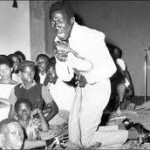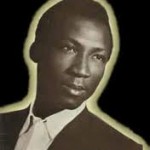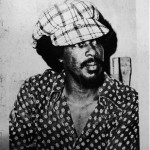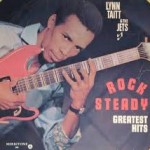The stage was being set for a plethora of such songs that would transform the Jamaican musical landscape forever. All of a sudden, there was a rhythmic shift in the focus of recordings from the fast horns-dominated songs to more emphasis being placed on the bass and the drum.
This feature, which has remained a major ingredient of Jamaican popular music, lasting into the dancehall era, has helped tremendously in bringing to the fore several vocalists, some of whom found the frantic pace of ska too fast for them to keep timing with the lyrics they had.
Many musicologists tend to agree that the man most responsible for this change was the Trinidadian-born guitarist Lynn Taitt. Quite interestingly, Taitt was invited to Jamaica by the popular Jamaican bandleader Byron Lee to participate in Jamaica’s Independence celebrations of 1962. He got caught up in the euphoria, fell in love with the island and its music, and decided to stay.
Taitt, a guitar genius, played with several local bands before forming the Comets in themid-1960s. Putting together his classic aggregation – Lynn Taitt and The Jets – shortly after, he managed to acquire a major slice of the rocksteady market with a slew of instrumental hits, while doing musical arrangements and backings on hits like HoldThemby Roy Shirley, Talking Love by The Paragons, Silent River by the Gaylettes, Stop that Train, andTonight by Keith and Tex, Been so Long, Solomon, andWalk the Streets by Derrick Harriott. On the last cut, Harriott expressed to me his confidence in the guitarist: “I didn’t like it at first, and then I brought Lynn Taitt in, and immediately, you could feel the difference.”
Taitt’s introductory guitar strumming on the song was followed by Harriott’s haunting lyrics:
“Walk the street at night
looking for someone you’ll never find.
Whoa darling, you might as well forget him
for he’s gone, he said his last goodbye.”
Lyn Taitt and The Jets also helped to popularise other rocksteady classics like Roy Shirley’s Music Field, The Uniques’ Let Me Go Girl, The Ethiopians’ Train to Skaville, The Kingstonians’ Winey Winey, The Melodians’ Swing and Dine, The Gaylads’ AbcRocksteady, Ken Boothe’s Lady with the Starlight, and Johnny Nash’s Hold me Tight, which climbed to No. 5 on the UK charts in the summer of 1968.
But perhaps Taitt’s greatest moment was spent with Hopeton Lewis at the Federal Studios back in late 1966 as both men created what was arguably the first rocksteadyrecord: Take it Easy.
According to Taitt, “Lewis came to the Federal Studios with a song called Take it Easy, and I find the beat was too fast for the song. So I told them, ‘Let’s do this one slow’, and as the music got slower, it had spaces.”
UNDOCUMENTED EVIDENCE
Apart from Taitt and Lewis, there were no fewer than five other artists-producers who claim that they created the first rocksteady record.
Undocumented evidence, which plagued early Jamaican music, has however, made it virtually impossible to credit the true originator. Roy Rushton (stage name Roy Shirley), dubbed the high priest of reggae, was perhaps the main contender with Hold Them on Joe Gibbs’ Amalgamated label.

According to Shirley, he created the ‘one drop’ beat with this song, which he said was somewhat similar to the rocksteady. Producer Bunny Lee claims that it would be a toss-up between his production of People Get Ready by The Uniques and Tougher Than Tough by Derrick Morgan. Alton Ellis also staked a claim with Girl I’ve Got A Date.

Notwithstanding all of this, the winds of change were blowing in the early to mid-1960swhen producer Clement ‘Coxson’ Dodd released a number of slowed-down ska songs, which had elements of rocksteady. Peter Tosh’s first solo hit, I’m the Toughest, was one such recording.
It was an uncompromising description of himself, which pointed in the direction which his career would take. The Wailers group, which included Tosh, also used this transitional ska beat to record Let Him Goin support of the rude boy syndrome, which sprung up shortly after Independence.
They sang:
‘Rudie gone a jail
but rudie get bail.
You frame him, you say things he didn’t do.
You rebuke him, you scorn him,
you make him feel blue.
I beg you, let him go’.

Bob Andy, employing the same pace – somewhere between ska and rocksteady – created the anthemic masterpiece I’ve Got to Go Back Home in 1966. It was perhaps the first call for repatriation in popular music as Andy forthrightly sang:
‘This couldn’t be my home
it must be somewhere else
or I would kill myself.
Cause I can’t get no clothes to wear
Can’t get no food to eat
Can’t get a job to get break
That’s why I’ve got to go back home.’
The Ethiopians were in there too with I’m Gonna Take Over.
Then Delroy Wilson came with something closer to authentic rocksteady when he recorded I’m in a Dancing Mood. He followed that with Ungrateful Baby, Impossible, Riding for a Fall, and Close to Me. Ken Boothe had The train is Coming, I Don’t Want to See You Cry, and Don’t Cry Little Girl, while the Gaylads’ Stop Making Love Beside Me, No Good Girl, and You’ll Never Leave Him were very popular among Jamaicans.

The rocksteady beat, which reigned supreme until mid-1968, saw the emergence of several solo artistes, but groups such as The Paragons (Only a Smile and Happy Go lucky Girl), The Techniques (You Don’t Care andTravelling Man), The Melodians (I’ll Get Along Without You), The Heptones (Party Time and Pretty Looks isn’t All), and The Silvertones (Smile) dominated the genre.




You must log in to post a comment.